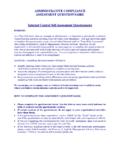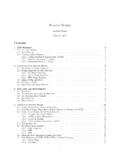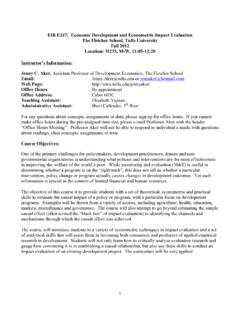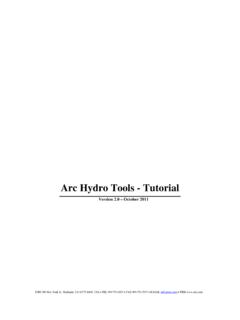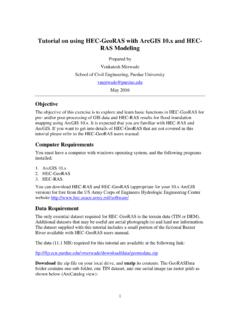Transcription of Watershed and Drainage Delineation by Pour Point in …
1 Watershed and Drainage Delineation by pour Point in ArcMap 10. Written by Barbara Parmenter and Jack Melcher, Revised January 10, 2012. SECTION 1 - PREPARING YOUR BASE MAP FOR Watershed Delineation .. 1. SECTION 2 - PROJECTING YOUR GIS DATA INTO THE UTM COORDINATE SYSTEM .. 2. SECTION 3 - DELINEATING A Watershed OVERVIEW OF STEPS .. 6. SECTION 4 - DELINEATING THE Watershed OF YOUR STREAM GAGE DETAILED 8. SECTION 5 - WHAT TO TURN 13. SECTION 6 OPTIONAL: DELINEATING THE Drainage NETWORK FOR YOUR AREA .. 14. In this tutorial, you will learn how to delineate the boundary of a stream gage's Drainage area ( Watershed polygon) based on a Digital Elevation Model (DEM) and optionally how to delineate the Drainage network (lines) within the Watershed . You will use the same the stream gage data Point and DEM that you used in Tutorial 1 - ArcGIS Basics for Water Resources Mapping. (S:\ tutorials \Tufts\Tutorial Data\ Watershed Delineation by pour Point ).
2 Note: if your area is fairly flat, the Watershed area Delineation will not be accurate. Section 1 - Preparing your base map for Watershed Delineation 1. Before you begin, create a new folder called ProcessedData in your HydroGIS project folder. 1. 2. Start ArcMap with a new map. 3. Start a new ArcMap session with the following layers: a. The flowlines upstream from your gaging station ( from Tutorial 1). b. Your stream gage Point ( from Tutorial 1) this will be your reference for your pour Point c. NED_xxxx (your DEM) for your subbasin (from Tutorial 1). 4. It is also useful for context to add the Shaded Relief from ArcGIS Online (to do this, click on File . Add Data Add Basemap Terrain and then display the Shaded Relief layer). 5. Save your map file (File-Save) to your project folder call it Watershed Delineation Base Section 2 - Projecting your GIS data into the UTM Coordinate System Before proceeding with Watershed Delineation or any other kind of hydrological analysis, your data sets need to be in a projected coordinate system in which the horizontal units of the xy coordinates are the same as the vertical elevation units of your DEM.
3 Your DEM elevation values are in meters. But the horizontal units of your DEM are in spherical degrees, and the DEM data set is NOT. projected it is still in spherical coordinates. So we need to project our DEM into a coordinate system in which the horizontal units of the xy coordinates are in meters, not degrees. One coordinate system that fits our needs is called UTM NAD 83 (for Universal Transverse Mercator, based on the North American Datum of 1983). The UTM system divides the world up into 60 zones, and you need to know which zone your stream gage is in. There are several ways to find this out . use ONE of the following: Look at the map of UTM Zones for the United States at the end of this tutorial. Use Google Earth 2. a. In Google Earth, Under Tools-Options go to the 3D View tab and set Show Lat/Long to Universal Transverse Mercator: b. In the Google Earth Fly To search box, enter the lat/long coordinates of your stream gage (or just zoom into the area if you know where it is).
4 At the bottom of the view you will see coordinate information the first number (19 below) is the UTM Zone number: If you are in the Tufts GIS Lab, you can add the UTM from the M:\World\ESRIDataMaps93\Vector\ folder. When the UTM Grid appears, you should see the Zone Number labeled somewhere in the center of your map If you are working at a different Tufts computer lab, click on the Connect to Folder icon, and enter \\rstore2\gis$\datasets. This will connect you with the M drive in the GIS lab. Add the UTM as described above. 3. 6. Now that you know the UTM Zone number for your stream gage area, you are going to change the coordinate system of your current map (called your Data Frame) to this UTM zone number . this DOES NOT change the coordinate systems of the individual data sets just the DATA FRAME. containing those data sets: a. Click on View Data Frame Properties b. Go to the Coordinate System Tab and under Select a Coordinate System, choose Predefined- Projected Coordinate Systems UTM NAD 1983 and from there click on your stream gage's UTM zone ( , 19N) and click OK (note that all UTM Zones NORTH.)
5 Of the equator are labeled N!): c. Click YES to proceed when warned about the coordinate system being different from some of your data layers we're going to fix that now! d. If you previously added UTM Grid layer, remove it now. e. Save your map file (File-Save). 4. 7. In order to reduce computing times and file sizes we are only going to project the portion of the DEM that we will be performing the Watershed Delineation on. Zoom to your HCDN_tributaries layer and then zoom out slightly so that you know you will be displaying the entire tributary Watershed in your view window. 8. Right-click on the DEM data layer and choose Data Export Data. Carefully follow the screen shot below for guidance. You want to export just the extent of the DEM that fills your Data Frame, and you want the spatial reference (coordinate system) to be the same as the Data Frame (UTM NAD83). The 1-arc second DEM you are using has square cells equal to 30 meters to a side.
6 Use the folder icon ( ) to set the save location to your project folder (ProcessedData), but don't try to name the file through the Select Workspace dialog. Instead, use the Name field and name exported file DemClip. Finally, change the raster format to GRID . again, see the example below: 9. Click Save 10. Add the exported data file to the map when prompted 5. 11. Save your mapfile (File-Save). Section 3 - Delineating a Watershed Overview of Steps ArcGIS can delineate the total area flowing into a given outlet, also called a pour Point , based on a digital elevation model. In this analysis, the pour Point will be your stream gage, and you will delineate the Watershed upstream of your stream gage. Recall that a digital elevation model is an array of evenly spaced grid cells, and that the value of each cell is the estimated elevation of that cell. ArcGIS can compute from the DEM the direction of flow down a slope and how many cells flow into each cell (called flow accumulation).
7 Here is a quick overview of the steps for delineating a Watershed in ArcGIS . we have detailed directions later. Note that you should carefully review the ArcGIS Help for this topic . you can find it in the software under Help ArcGIS Desktop Help Extensions Spatial Analyst Analysis Concepts Hydrologic Analysis, or online starting here (in both cases, each step has its own detailed section): # The USGS Hydrosheds Project ( ) is another good source for understanding this process, and discusses more complex technical issues than we cover here. Conceptual overview of Watershed Delineation : 1. Flow Direction: Based on your clipped DEM (DemClip) this will compute for every cell the direction that water would flow through it. The value of the cell is a number representing a cardinal direction as shown here: The output data set is FlowDirxx 2. Sink: This step uses your Flow Direction grid to identify sinks in your DEM.
8 These are areas surrounded by higher areas, so that there is no external Drainage . Sometimes sinks are real, but often DEMs have erroneous sinks. Regardless of whether they are real or not, for the Watershed 6. Delineation process to work, we need a depressionless DEM, , a DEM with no sinks. The Output data set is Sink_FlowDirxx. 3. Fill: This step will fill the sinks of your DEM (DemClip). Note that doing this correctly requires care and an iterative process which we don't detail in this tutorial. Instead, we will do a basic Fill command. The result of this step will be a depressionless DEM (Fill_Demxx) which will in turn be the basis of the rest of the process 4. A new Flow Direction based on the Filled (depressionless) DEM. The result will be FlowDir_Fillxx 5. Flow Accumulation based on your new corrected (filled) Flow Direction grid: This step calculates for each cell in your filled DEM array, the number of cells flowing into it).
9 Areas of higher values are where water collects and drains. Areas of very high values are likely perennial streams or rivers, areas with lower values may be intermittent streams. The Flow Accumulation grid will allow the software to determine the area draining to any specified Point on the DEM ( , your stream gage). The output grid is FlowAccxx 6. Snap pour Point : Your stream gage Point may not fall directly over the correct raster cell (all GIS. data have inherent positional error). Since a stream gage is by definition next to a stream, we know that the pour Point representing the gage should be coincident with the stream. The Snap pour Point command snaps your stream gage Point to the nearest area of high flow accumulation within a distance you specify. Your output grid will be SnapPour 7. Watershed : This command performs the Watershed Delineation based on your snapped stream gage pour Point (SnapPour). 7. Section 4 - Delineating the Watershed of your Stream Gage Detailed Instructions Follow the process steps using tools in ArcToolbox Spatial Analyst Tools Hydrology DEMCLIP is your initial base: 1.
10 Initialize the Spatial Analyst Extension (Tools Extensions checkmark Spatial Analyst). 2. Open ArcToolbox ( ) to the Spatial Analyst Tools Hydrology section 3. You will go through the tools in turn a. Flow Direction for this initial process, set the Input Surface Raster to DemClip. For Output flow direction raster, navigate to your ProcessedData folder, and call the new raster FlowDir_DemC1, then press OK, as show below: 8. b. Sink The flow direction grid is the input: Examine the Sinks raster you have created. In a more detailed analysis, you would constrain the depth to which sinks are filled to eliminate small sinks due to errors in the DEM, but not actual basins. This process is iterative and very time consuming, and so will not be covered in this tutorial, but you can read about it on the ESRI online help or the USGS Hydrosheds Project ( ). c. Fill d. Flow Direction based on the filled DEM - 9. e. Flow Accumulation (may take a long time) - f.

